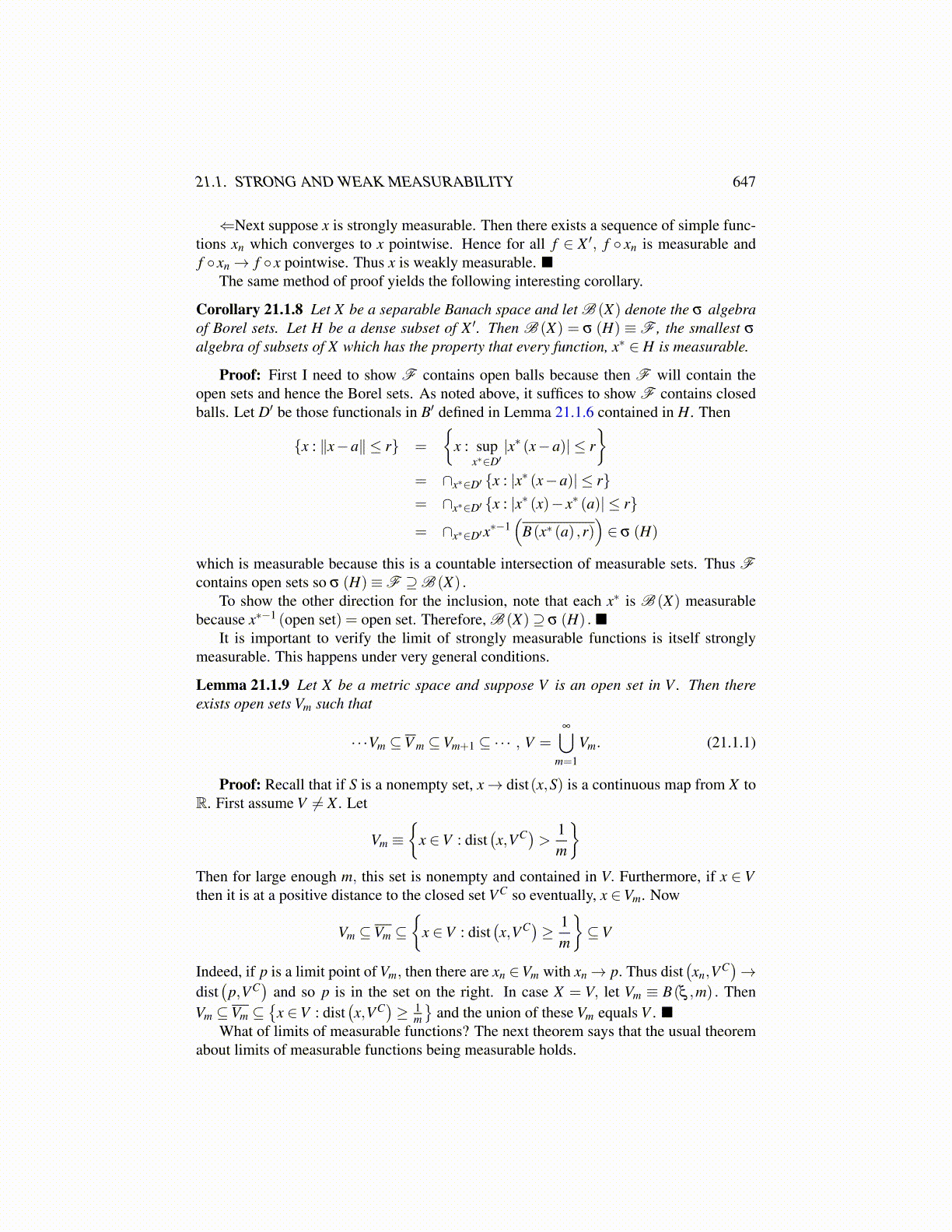
21.1. STRONG AND WEAK MEASURABILITY 647
⇐Next suppose x is strongly measurable. Then there exists a sequence of simple func-tions xn which converges to x pointwise. Hence for all f ∈ X ′, f ◦ xn is measurable andf ◦ xn→ f ◦ x pointwise. Thus x is weakly measurable.
The same method of proof yields the following interesting corollary.
Corollary 21.1.8 Let X be a separable Banach space and let B (X) denote the σ algebraof Borel sets. Let H be a dense subset of X ′. Then B (X) = σ (H) ≡F , the smallest σ
algebra of subsets of X which has the property that every function, x∗ ∈ H is measurable.
Proof: First I need to show F contains open balls because then F will contain theopen sets and hence the Borel sets. As noted above, it suffices to show F contains closedballs. Let D′ be those functionals in B′ defined in Lemma 21.1.6 contained in H. Then
{x : ∥x−a∥ ≤ r} =
{x : sup
x∗∈D′|x∗ (x−a)| ≤ r
}= ∩x∗∈D′ {x : |x∗ (x−a)| ≤ r}= ∩x∗∈D′ {x : |x∗ (x)− x∗ (a)| ≤ r}
= ∩x∗∈D′x∗−1(
B(x∗ (a) ,r))∈ σ (H)
which is measurable because this is a countable intersection of measurable sets. Thus Fcontains open sets so σ (H)≡F ⊇B (X) .
To show the other direction for the inclusion, note that each x∗ is B (X) measurablebecause x∗−1 (open set) = open set. Therefore, B (X)⊇ σ (H) .
It is important to verify the limit of strongly measurable functions is itself stronglymeasurable. This happens under very general conditions.
Lemma 21.1.9 Let X be a metric space and suppose V is an open set in V . Then thereexists open sets Vm such that
· · ·Vm ⊆V m ⊆Vm+1 ⊆ ·· · , V =∞⋃
m=1
Vm. (21.1.1)
Proof: Recall that if S is a nonempty set, x→ dist(x,S) is a continuous map from X toR. First assume V ̸= X . Let
Vm ≡{
x ∈V : dist(x,VC)> 1
m
}Then for large enough m, this set is nonempty and contained in V. Furthermore, if x ∈ Vthen it is at a positive distance to the closed set VC so eventually, x ∈Vm. Now
Vm ⊆Vm ⊆{
x ∈V : dist(x,VC)≥ 1
m
}⊆V
Indeed, if p is a limit point of Vm, then there are xn ∈Vm with xn→ p. Thus dist(xn,VC
)→
dist(
p,VC)
and so p is in the set on the right. In case X = V, let Vm ≡ B(ξ ,m) . ThenVm ⊆Vm ⊆
{x ∈V : dist
(x,VC
)≥ 1
m
}and the union of these Vm equals V .
What of limits of measurable functions? The next theorem says that the usual theoremabout limits of measurable functions being measurable holds.